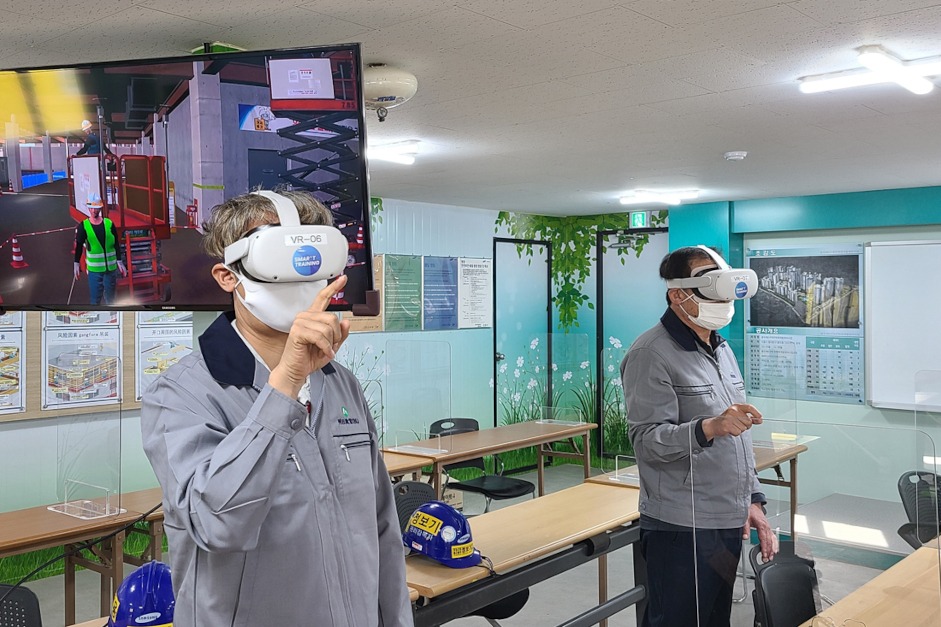
Integrating Technology in Workplace Safety Training
In an era defined by rapid technological advancement, every facet of business operations is undergoing a profound transformation. From manufacturing processes to communication strategies, technology is reshaping how we work, innovate, and connect. Workplace safety, a cornerstone of any responsible organization, is no exception. Gone are the days when safety education relied solely on lengthy manuals, monotonous lectures, and static presentations. Today, forward-thinking companies are embracing cutting-edge tools to deliver more effective, engaging, and memorable safety training.
The integration of technology into workplace safety training isn’t just a trend; it’s a strategic imperative. It addresses the limitations of traditional methods, enhances learning retention, and prepares employees more effectively for real-world hazards. This blog post will delve into how various technologies, particularly online training, VR training, and virtual reality, are revolutionizing safety education, highlighting their benefits, challenges, and best practices for implementation.
The Evolution of Safety Training: From Classroom to Cloud
For decades, safety training primarily took place in a classroom setting. While foundational, this approach often struggled with scalability, consistency, and engagement. Scheduling large groups, accommodating different learning paces, and ensuring uniform delivery across multiple sites presented significant logistical hurdles. The advent of digital tools began to chip away at these challenges, paving the way for more flexible and accessible solutions.
The Rise of Online Training: Accessibility and Consistency
One of the earliest and most impactful technological shifts in safety education has been the widespread adoption of online training. eLearning platforms have transformed how companies deliver essential safety information, offering unparalleled accessibility and consistency.
Online training modules can be accessed anytime, anywhere, allowing employees to complete courses at their own pace and convenience. This flexibility is invaluable for organizations with diverse workforces, remote employees, or those operating across multiple shifts. Key benefits include:
- Accessibility: Employees can log in from any device with an internet connection, breaking down geographical and time barriers.
- Flexibility: Learners can pause, review, and resume training sessions as needed, optimizing their learning experience.
- Cost-Effectiveness: Reduced need for physical classroom space, travel expenses for instructors and trainees, and printed materials leads to significant cost savings.
- Consistency: Every employee receives the exact same high-quality content, ensuring standardized knowledge dissemination across the organization.
- Tracking and Reporting: Learning Management Systems (LMS) provide robust tools for tracking completion rates, scores, and individual progress, simplifying compliance reporting and identifying areas for improvement.
- Scalability: Easily deploy training to hundreds or thousands of employees simultaneously, making it ideal for large enterprises or rapid onboarding.
From basic hazard communication to emergency response procedures, online training has become a fundamental component of modern safety training programs, laying the groundwork for more advanced technological integrations.
The Immersive Frontier: VR Training and Virtual Reality
While online training offers excellent accessibility, it often remains a passive learning experience. To truly simulate hazardous environments and allow for hands-on, risk-free practice, industries are increasingly turning to immersive technologies, most notably VR training and virtual reality.
Virtual reality creates a simulated environment that can be experienced and interacted with in a seemingly real way. For safety training, this means recreating dangerous scenarios without any actual risk to the trainee. Imagine:
- Confined Space Entry: Trainees can virtually navigate tight, dark, and potentially oxygen-deficient spaces, learning proper entry protocols, atmospheric monitoring, and rescue procedures without ever entering a real confined space.
- Lockout/Tagout (LOTO) Procedures: Employees can practice the precise steps of isolating energy sources, applying locks and tags, and verifying zero energy states on virtual machinery. This builds muscle memory and reinforces critical procedural adherence.
- Fire Safety and Emergency Evacuation: Trainees can experience a simulated fire, learn to use a virtual fire extinguisher, identify escape routes, and practice emergency communication in a high-stress, yet safe, environment.
- Equipment Operation: Novice operators can practice complex machinery controls, learn safe operating distances, and respond to virtual equipment malfunctions, reducing the risk of real-world damage or injury.
- Hazard Recognition: Workers can walk through a virtual job site, identifying potential slip, trip, fall, or struck-by hazards, and then virtually implement corrective actions.
The benefits of VR training are transformative:
- Experiential Learning: Trainees don’t just read about safety; they experience it. This active engagement leads to significantly higher knowledge retention and skill transfer.
- Risk-Free Practice: Mistakes made in a virtual reality environment have no real-world consequences, allowing trainees to learn from errors without danger.
- Muscle Memory Development: Repeated practice of safety procedures in a realistic virtual environment helps build crucial muscle memory, leading to more instinctive and correct responses in actual emergencies.
- Enhanced Engagement: The novelty and interactivity of VR training captivate learners, making safety topics more exciting and memorable.
- Realistic Scenarios: VR can replicate highly specific or rare hazardous situations that would be impractical, too dangerous, or too costly to simulate in the real world.
- Cost Savings: While the initial investment in virtual reality hardware and software can be significant, it often leads to long-term savings by reducing the need for expensive physical mock-ups, equipment downtime for training, and potential accident costs.
- Performance Metrics: VR systems can collect detailed data on trainee performance, identifying weaknesses, tracking progress, and providing personalized feedback.
Beyond VR: A Spectrum of Innovative Safety Technologies
While online training and VR training are leading the charge, other technologies are also making significant contributions to the evolution of workplace safety training:
- Augmented Reality (AR): Unlike VR, which immerses users in a virtual world, AR overlays digital information onto the real world. In safety training, AR can provide real-time guidance, highlighting hazardous components on actual machinery, displaying safety checklists, or offering step-by-step instructions for complex procedures directly in the user’s field of vision via smart glasses or tablets.
- Gamification: Integrating game-like elements (points, badges, leaderboards, challenges) into safety training makes the learning process more enjoyable and motivating. This can be applied to both online training modules and more immersive VR experiences, fostering healthy competition and encouraging repeated engagement with safety content.
- Artificial Intelligence (AI) and Machine Learning (ML): AI can personalize learning paths based on a trainee’s performance and knowledge gaps, ensuring they receive targeted instruction. ML can analyze accident data to predict future risks and inform the development of more effective safety training programs, moving from reactive to proactive safety measures.
- Wearable Technology: Smart wearables (e.g., smart helmets, safety vests with sensors) can monitor environmental conditions, worker biometrics, and proximity to hazards in real-time. While primarily for active safety, the data collected can inform and personalize future safety training needs, identifying common risky behaviors or environments.
The Transformative Impact: Why Tech-Driven Safety is Superior
The collective impact of these technologies on workplace safety training is transformative, moving beyond mere compliance to foster a deeply ingrained culture of safety:
- Enhanced Learning Retention: Active, experiential learning through VR and interactive online training modules leads to significantly better retention of information and skills compared to passive learning methods. When trainees do rather than just hear, the knowledge sticks.
- Standardization and Consistency: Technology ensures that every trainee, regardless of location or instructor, receives the same high-quality, consistent safety training. This eliminates variations in delivery and ensures a uniform understanding of critical safety protocols.
- Cost Efficiency (Long-Term): While initial investment can be a factor, the long-term cost savings are substantial. Reduced travel, fewer instructor hours, less wear and tear on physical equipment, and most importantly, a decrease in accident-related costs (medical, legal, downtime) make technology a financially sound investment.
- Scalability: Deploying safety training to a large workforce or across multiple global sites becomes significantly easier and faster with digital platforms and VR simulations.
- Data-Driven Insights: Technology provides invaluable data on trainee performance, common errors, and areas requiring more focus. This allows safety managers to continuously refine their safety training programs, making them more effective and targeted.
- Improved Engagement and Motivation: Modern learners, especially younger generations, are accustomed to interactive digital experiences. Leveraging these technologies makes safety training more appealing, combating “training fatigue” and fostering a proactive approach to safety.
Navigating the Challenges of Integration
Despite the immense benefits, integrating technology into workplace safety training is not without its challenges:
- Initial Investment: The cost of VR headsets, specialized software development, and robust IT infrastructure can be a barrier for some organizations.
- Technological Literacy: Ensuring that both trainees and trainers are comfortable with the new technologies requires adequate support and initial training.
- Content Development: Creating high-quality, effective virtual reality simulations or interactive online training modules requires specialized skills and can be time-consuming.
- Maintaining the Human Element: While technology enhances learning, it should not entirely replace human interaction. Debriefing sessions, Q&A with instructors, and opportunities for peer discussion remain crucial for reinforcing learning and addressing nuanced situations.
- Accessibility: Ensuring that technological solutions are accessible to all employees, including those with disabilities or limited internet access, is paramount.
- Regular Updates: Technology evolves rapidly, and content must be regularly updated to reflect new regulations, equipment, and best practices.
Best Practices for Successful Integration
To maximize the impact of technology in safety training, consider these best practices:
- Start Small, Pilot Programs: Don’t try to overhaul your entire safety training program at once. Start with pilot programs for specific, high-risk areas or complex procedures.
- Define Clear Learning Objectives: Before developing any tech-based training, clearly articulate what skills and knowledge trainees should acquire.
- Embrace Blended Learning: Combine the strengths of different approaches. Use online training for foundational knowledge, VR training for practical skills, and instructor-led sessions for discussion and complex problem-solving.
- Invest in Quality Content: Poorly designed virtual reality simulations or unengaging online training modules will be ineffective. Prioritize high-quality content development.
- Provide Adequate Support: Offer technical support for the technology and instructional support for the content.
- Measure Effectiveness: Continuously evaluate the impact of your tech-driven training on accident rates, compliance, and employee competency. Use data to refine and improve.
Conclusion: A Safer Future, Powered by Technology – Partner with PITC KSA
The future of workplace safety training is undeniably intertwined with technological innovation. By strategically integrating online training, VR training, and other forms of virtual reality and digital tools, organizations can move beyond traditional compliance checkboxes to create truly immersive, engaging, and effective learning experiences. This not only equips employees with the critical skills needed to navigate hazardous environments safely but also cultivates a proactive safety culture that prioritizes well-being. Embracing these advancements is not just about staying competitive; it’s about building a safer, more resilient, and ultimately more human-centric workplace for everyone. The time to invest in a tech-powered safety future is now.
As a leading safety training center, Progressive International Training Center (PITC KSA) is uniquely positioned to help your organization achieve these goals. Located conveniently in Jubail, just a 10-minute drive from Jubail City Center, PITC KSA offers state-of-the-art facilities and expert instructors ready to guide your team through the latest in safety education, including advanced technological integrations. Partner with PITC KSA to empower your workforce with the knowledge and skills for a safer, more productive tomorrow.
